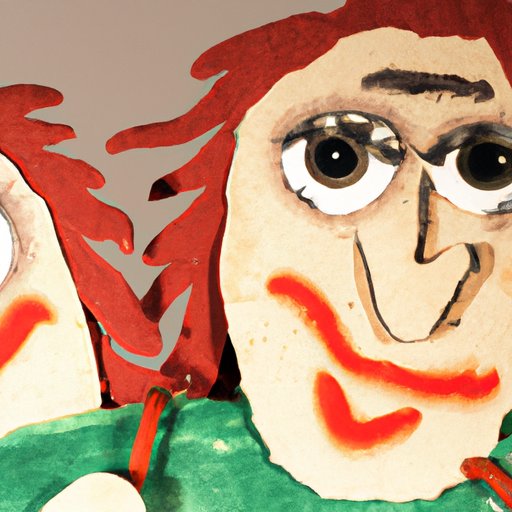
Introduction
Puppetry has been around for centuries as a form of entertainment, communication, and education. Making a puppet is not only a fun and creative activity, but it also has educational and therapeutic benefits. In this article, we will explore how to make a puppet, how to make a puppet show, the art of puppetry, creating characters, making puppets with kids, and more.
DIY Puppet Making: A Step-by-Step Guide for Beginners
Making your own puppet is easier than you may think. Here are some basic steps to get you started:
1. Materials: First, gather all the materials you need. Basic materials for a hand puppet include foam, felt fabric, googly eyes, glue, and scissors.
2. Pattern: Draw a pattern for your puppet on paper. Cut out the basic shape of the puppet and lay it on the felt fabric.
3. Cut the Fabric: Trace around your paper pattern and cut out the felt fabric according to the shape.
4. Glue: Glue the different pieces together. Start with the body, then add the arms, legs, and head.
5. Decorate: Add details to your puppet using markers, fabric glue, and other embellishments. Make sure to leave a small hole in the bottom of the puppet for your hand to fit through.
6. Final Touches: Finally, add eyes and other features to give your puppet some personality.
How to Make a Puppet Show: Bringing Your Characters to Life
Now that you have your puppet, it’s time to bring it to life. Here are some tips for creating a compelling and entertaining puppet show:
1. Script: Begin by creating a script for your puppet show. Your story should have a clear beginning, middle, and end. Make sure your characters are well-defined and have distinct personalities.
2. Stage: Think about the space you are working with. You can create a stage using a cardboard box, or you can use a puppet theater. Use props and backdrops to add depth to your show.
3. Sound Effects: You can add music and sound effects to your performance to enhance the mood and create a more immersive experience.
4. Audience Interaction: Make sure to engage your audience by asking them questions or inviting them to participate in the show. Use call and response or make your characters jump off the stage and interact with the audience.
The Art of Puppetry: An Exploration of Techniques and Materials
Puppetry is an art form that has evolved over time with different techniques and materials. Here are some tips for using different materials to create a puppet:
1. Paper Mache: Paper mache is a popular material for making puppets. To make a basic puppet using paper mache, create a wireframe of the puppet, then layer paper strips soaked in a glue mixture over the frame until it is covered.
2. Foam: Another popular material for making puppets is foam. This material is lightweight and durable. To make a foam puppet, sketch out the puppet design on foam sheets and cut out the shapes. Glue the shapes together to form the puppet.
3. Fabric: You can also create a puppet using fabric. Use a sewing machine or hand-sew the different pieces together. You can stuff the puppet with cotton to give it a three-dimensional shape.
4. Hand Puppets vs. Marionettes: There are different types of puppets, including hand puppets and marionettes. Hand puppets are operated with one hand and are easier to control. Marionettes are controlled with strings and require more skill to operate.
Creating Characters: Using Puppetry to Develop Your Creative Expression
Puppetry is not just about the puppet itself; it’s also about the character behind it. Here are some tips for creating your own puppet characters:
1. Brainstorm: Start by brainstorming ideas for your puppet character. Think about different personality traits, physical features, and backstories.
2. Personality: Give your puppet character a distinct personality. Think about their likes and dislikes, their goals, and their fears.
3. Backstory: Develop a backstory for your puppet character. Think about where they came from, what their family is like, and what their life has been like so far.
4. Storytelling: Using your puppet character, you can tell stories and express yourself creatively. Use your puppet as a way to explore different themes and topics.
Making Puppets with Kids: A Fun and Educational Activity
Making puppets with kids is a great way to engage their creativity and foster their imagination. Here are some tips for making puppets with children:
1. Materials: Use safe and non-toxic materials when making puppets with children. Foam, felt, and paper are all good options.
2. Adaptation: Adapt the activity to the age and skill level of the children. For younger children, simplify the design and focus on basic shapes.
3. Games: Once the puppets are made, use them to play games and tell stories. Encourage the children to use their imagination and explore different scenarios.
4. Benefits: Puppet-making has many benefits for children, including motor skills development, social development, and imagination and creativity development.
Conclusion
Puppetry is a creative and educational outlet for children and adults alike. Creating your own puppet is a fun and rewarding experience. Whether you’re making a puppet show or just exploring your creative expression, puppetry offers endless possibilities.




